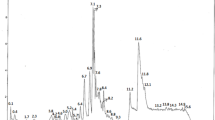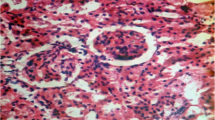Abstract
Occupational and environmental exposure to chromium compounds leads to nephrotoxicity to humans and animals due to the overproduction of ROS. Our study was aimed to demonstrate the shielding effect of hydroethanolic extract of Ipomoea staphylina (HEIS) bark on male Wistar rats challenged with potassium dichromate (K2Cr2O7). Division of animals was done in 4 groups’ viz., normal control, K2Cr2O7 control, K2Cr2O7+HEIS (100 mg/kg), and K2Cr2O7+HEIS (200 mg/kg). Except for the normal control group, other groups were challenged with a single dose (subcutaneous) of K2Cr2O7 (15 mg/kg) and then treated with HEIS (100 and 200 mg/kg) for 1 week. It was observed that animals treated with K2Cr2O7 showed a notable increase in serum creatinine, blood urea, and BUN and dwindles in protein level. These changes were significantly reversed after a 1-week treatment with HEIS (100 and 200 mg/kg). Moreover, HEIS (100 and 200 mg/kg) showed a remarkable improvement in the activity of antioxidant enzymes (GPx, CAT, and SOD) and decreased the levels of TNF-α and IL-1β in the kidney. Furthermore, treatment with HEIS (100 and 200 mg/kg) notably decreased the activity of caspase-3 and improved the level of HO-1 especially in the K2Cr2O7+ HEIS (200 mg/kg) group. Also, the histopathological study of the kidney supported the protective effects of HEIS. Hence, HEIS bark holds a notable protective effect against K2Cr2O7-induced nephrotoxicity in rats.


Similar content being viewed by others
REFERENCES
Yatera, K., Morimoto, Y., Ueno, S., Noguchi, S., Kawaguchi, T., Tanaka, F., Suzuki, H., and Higashi, T., Cancer risks of hexavalent chromium in the respiratory tract, J. Uoeh., 2018, vol. 40, pp. 157–172.
Pechova, A. and Pavlata, L., Chromium as an essential nutrient: a review, Vet. Med., 2007, vol. 52, no. 1, pp. 1–18.
Suh, M., Wikoff, D., Lipworth, L., Goodman, M., Fitch, S., Mittal, L., Ring, C., and Proctor, D., Hexavalent chromium and stomach cancer: a systematic review and meta-analysis, Crit. Rev. Toxicol., 2019, vol. 49, no. 2, pp. 140–159.
Guo, Y., Wang, Y., and Huang, B., The acute toxicity effects of hexavalent chromium in antioxidant system and gonad development to male clam Geloina coaxans, Eur. Zool. J., 2020, vol. 87, no. 1, pp. 325–335.
EL-Guendouz, S., Zizi, S., Elamine, Y., and Lyoussi, B., Preliminary screening of the possible protective effect of moroccan propolis against chromium induced nephrotoxicity in animal model, Vet. World, 2020, vol. 13, no. 7, pp. 1327–1333.
Wu, F., Li, S., Zhang, N., Huang, W., Li, X., Wang, M., Bai, D., and Han, B., Hispidulin alleviates high-glucose-induced podocyte injury by regulating protective autophagy, Biomed. Pharmacother., 2018, vol. 104, pp. 307–314.
Athira, K., Madhana, R.M., and Lahkar, M., Flavonoids, the emerging dietary supplement against cisplatin-induced nephrotoxicity, Chem. Biol. Interact., 2016, vol. 248, pp. 18–20.
Bag, A.K. and Mumtaz, S.M.F., Hepatoprotective and nephroprotective activity of hydroalcoholic extract of Ipomoea staphylina leaves, Bangladesh J. Pharmacol., 2013, vol. 8, pp. 263–268.
OECD, 2002. Acute Oral Toxicity. Acute Oral Toxic Class Method Guideline 423 Adopted 3.03.1996, in Eleventh Addendum to the OECD Guidelines for the Testing of Chemicals Organisation for Economic Co-Operation Development, Paris, June, 2000.
Bucher, J.R., NTP toxicity studies of sodium dichromate dihydrate (CAS No. 7789-12-0) administered in drinking water to male and female F344/N rats and B6C3F1 mice and male BALB/c and am3-C57BL/6 mice, Toxic Rep. Ser., 2007; 72, pp. 1–G4.
Salminen, A. and Vihko, V., Lipid peroxidation in exercise myopathy, Exp. Mol. Pathol., 1983, vol. 38, pp. 380–388.
Dennis, J.M. and Witting, P.K., Protective role for antioxidants in acute kidney disease, Nutrients, 2017, vol. 9, no. 7, p. 718.
Araújo, L.S., Torquato, B.G.S., da Silva, C.A., Monteiro, M.L.G.D.R., Martins, A.L.M.D.S., da Silva, M.V., Reis, M.A.D., and Machado, J.R., Renal expression of cytokines and chemokines in diabetic nephropathy, Nephrology, 2020, vol. 21, p. 308.
Yorulmaz, H.O. and Konuskan, D.B., Antioxidant activity, sterol and fatty acid compositions of Turkish olive oils as an indicator of variety and ripening degree, J. Food Sci. Technol., 2017, vol. 54, no. 12, pp. 4067–4077.
MC, Rimessi, A., Bezzerri, V., Nicolis, E., Guerrini, A., Tacchini, M., Tamanini, A., Munari, S., D’Aversa, E., Santangelo, A., Lippi, G., Sacchetti, G., Pinton, P., Gambari, R., Agostini, M., and Cabrini, G., β-sitosterol reduces the expression of chemotactic cytokine genes in cystic fibrosis bronchial epithelial cells, Front. Pharmacol., 2017, vol. 8, p. 236.
Bashandy, S.A.E., Mohamed, M.A., Morsy, F.A., and El-Marasy SA. Amelioration of the nephrotoxic effect of potassium dichromate by whey protein and/or Nigella sativa oil in male albino rats, J. Appl. Pharm. Sci., 2016, vol. 6, no. 8, pp. 44–50.
Parveen, K., Khan, M.R., and Siddiqui, W.A., Pycnogenol® prevents potassium dichromate (K2Cr2O7)-induced oxidative damage and nephrotoxicity in rats, Chem. Biol. Interact., 2009, vol. 181, pp. 343–350.
Shirazi, M., Eslahi, A., Shari, V., Rahimi, F., and Safarpour, A., Evaluation of caspase 3 enzyme and TNF-alpha as biomarkers in ureteropelvic junction obstruction in children—a preliminary report, Pak. J. Med. Sci., 2017, vol. 33, no. 2, pp. 315–319.
Pei, J., Cai, S., Song, S., Xu, Y., Feng, M., Luo, G., Wang, Y., Sun, F., Shi, H., and Xu, S., Normobaric hyperoxia plays a protective role against renal ischemia-reperfusion injury by activating the Nrf2/HO-1 signaling pathway, Biochem. Biophys. Res. Commun., 2020, vol. 532, no. 1, pp. 151–158.
ACKNOWLEDGMENTS
The authors gratefully acknowledge Department of Nephrology of Chengdu Fifth People’s Hospital for providing facilities to carry out the work.
Author information
Authors and Affiliations
Corresponding author
Ethics declarations
CONFLICT OF INTEREST
Authors have declared that there is no conflict of interest.
COMPLIANCE WITH ETHICAL STANDARDS
The study on animals was approved by the Animal Ethics Committee of Chengdu Fifth People’s Hospital, Sichuan, China (ethics number: cddwrmyy2019122801).
ABBREVIATIONS
AR—Analytical reagent, BUN—Blood Urea Nitrogen, CAT—Catalase, GSH—Reduced Glutathione, GPx—Glutathione Peroxidase, H&E—Hematoxylin and Eosin, HO-1—Heme Oxygenase 1, IL-1β—Interleukin-1β, LPO—Lipid Peroxidation, O2•−—Superoxide Anion, Nrf2— Nuclear factor erythroid 2-related factor 2, SOD—Superoxide Dismutase, TNF-α—Tumor Necrosis Factor-α.
Rights and permissions
About this article
Cite this article
Feng, H., Feng, Q., Xiao, T. et al. Ipomoea staphylina Attenuates Potassium Dichromate-Induced Nephrotoxicity in Wistar Rats via Antioxidant and Antiapoptotic Effects. Dokl Biochem Biophys 499, 289–295 (2021). https://doi.org/10.1134/S1607672921040074
Received:
Revised:
Accepted:
Published:
Issue Date:
DOI: https://doi.org/10.1134/S1607672921040074




